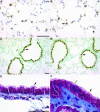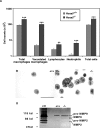Impact of the loss of Hoxa5 function on lung alveogenesis
- PMID: 17003488
- PMCID: PMC1698857
- DOI: 10.2353/ajpath.2006.051333
Impact of the loss of Hoxa5 function on lung alveogenesis
Abstract
The involvement of genes controlling embryonic processes in the etiology of diseases often escapes attention because of the focus given to their inherent developmental role. Hoxa5 belongs to the Hox gene family encoding transcription factors known for their role in skeletal patterning. Hoxa5 is required for embryonic respiratory tract morphogenesis. We now show that the loss of Hoxa5 function has severe repercussions on postnatal lung development. Hoxa5-/- lungs present an emphysema-like morphology because of impaired alveogenesis. Chronic inflammation characteristics, including goblet cell hyperplasia, mucus hypersecretion, and recruitment of inflammatory cells, were also observed. Altered cell specification during lung morphogenesis triggered goblet cell anomalies. In addition, the defective motility of alveolar myofibroblast precursors in the embryonic lung led to the mispositioning of the alveolar myofibroblasts and to abnormal elastin deposition postnatally. Both goblet cell hyperplasia and elastic fiber abnormalities contributed to the chronic physiopathological features of Hoxa5-/- lungs. They constituted an attractive stimulus to recruit activated macrophages that in turn generated a positive feedback loop that perpetuated macrophage accumulation in the lung. The present work corroborates the notion that altered Hox gene expression may predispose to lung pathologies.
Figures









Similar articles
-
[Hoxa5: a master gene with multifaceted roles].Med Sci (Paris). 2009 Jan;25(1):77-82. doi: 10.1051/medsci/200925177. Med Sci (Paris). 2009. PMID: 19154698 Review. French.
-
Comparative analysis of Hoxa5 allelic series.Genesis. 2007 Apr;45(4):218-28. doi: 10.1002/dvg.20292. Genesis. 2007. PMID: 17417799
-
Cooperation of Hoxa5 and Pax1 genes during formation of the pectoral girdle.Dev Biol. 2002 Apr 1;244(1):96-113. doi: 10.1006/dbio.2002.0596. Dev Biol. 2002. PMID: 11900462
-
Regulation of the Hoxa4 and Hoxa5 genes in the embryonic mouse lung by retinoic acid and TGFbeta1: implications for lung development and patterning.Dev Dyn. 2000 Jan;217(1):62-74. doi: 10.1002/(SICI)1097-0177(200001)217:1<62::AID-DVDY6>3.0.CO;2-U. Dev Dyn. 2000. PMID: 10679930
-
Function and specificity of Hox genes.Int J Dev Biol. 2009;53(8-10):1404-19. doi: 10.1387/ijdb.072462df. Int J Dev Biol. 2009. PMID: 19247930 Review.
Cited by
-
MicroRNA-196a promotes non-small cell lung cancer cell proliferation and invasion through targeting HOXA5.BMC Cancer. 2012 Aug 9;12:348. doi: 10.1186/1471-2407-12-348. BMC Cancer. 2012. PMID: 22876840 Free PMC article.
-
Characterization of a novel Hoxa5eGFP mouse line.Dev Dyn. 2023 Apr;252(4):536-546. doi: 10.1002/dvdy.563. Epub 2023 Jan 17. Dev Dyn. 2023. PMID: 36577717 Free PMC article.
-
Temporal changes in Hox gene expression accompany endothelial cell differentiation of embryonic stem cells.Cell Adh Migr. 2011 Mar-Apr;5(2):133-41. doi: 10.4161/cam.5.2.14373. Epub 2011 Mar 1. Cell Adh Migr. 2011. PMID: 21200152 Free PMC article.
-
Global gene expression patterns in the post-pneumonectomy lung of adult mice.Respir Res. 2009 Oct 5;10(1):92. doi: 10.1186/1465-9921-10-92. Respir Res. 2009. PMID: 19804646 Free PMC article.
-
Subtypes of schizophrenia identified by multi-omic measures associated with dysregulated immune function.Mol Psychiatry. 2021 Nov;26(11):6926-6936. doi: 10.1038/s41380-021-01308-6. Epub 2021 Sep 29. Mol Psychiatry. 2021. PMID: 34588622
References
-
- Perl A-K, Whitsett JA. Molecular mechanisms controlling lung morphogenesis. Clin Genet. 1999;56:14–27. - PubMed
-
- Cardoso WV. Lung morphogenesis revisited: old facts, current ideas. Dev Dyn. 2000;219:121–130. - PubMed
-
- Warburton D, Schwarz M, Tefft D, Flores-Delgado G, Anderson KD, Cardoso WV. The molecular basis of lung morphogenesis. Mech Dev. 2000;15:55–81. - PubMed
-
- Rogers DF. Mucus hypersecretion in chronic obstructive pulmonary disease. Chronic obstructive pulmonary disease: pathogenesis to treatment. Novartis Symposium. 2001;234:65–83. - PubMed
-
- Barnes PJ. Small airways in COPD. N Engl J Med. 2004;350:2635–2637. - PubMed
Publication types
MeSH terms
Substances
LinkOut - more resources
Full Text Sources
Other Literature Sources
Medical
Molecular Biology Databases

